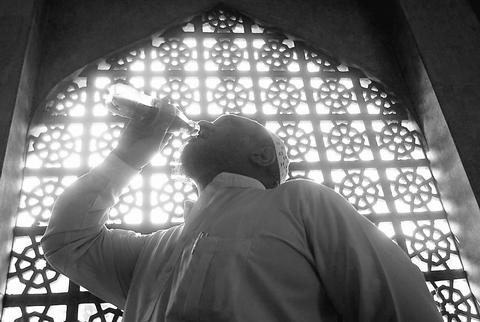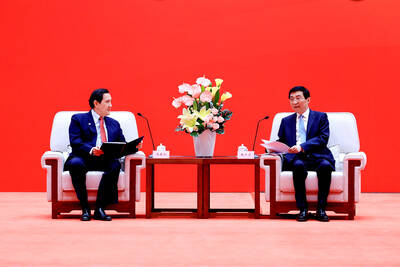For weeks, Satvika Prabhu, 15, and her friends in the ninth grade have been agog. They cannot seem to stop talking about each new blow and counterblow in an all-out marketing war between Coca-Cola and Pepsi-Cola, fought out on television with ads, counterads and counter-counterads as the weather starts to soar into summer heat.
New salvos appear almost daily, leaving Satvika and millions of Indians like her, mainstays of the US$1.2 billion soft drink market in India, engrossed and dying for more.
"The commercials are so cool," she said.

PHOTO: AP
The war started when Coca-Cola broadcast an ad featuring India's leading movie heartthrob, Aamir Khan, who endorsed Coke. The campaign happened to coincide with the news that Khan's latest blockbuster, Lagaan, was nominated for an Oscar for best foreign film -- it subsequently lost to
In the ad, Khan says, "Cold drink means ..." (He uses the generic Indian slang term thanda, which means cold drink.) After that pause, he completes the sentence with an enthusiastic "Coca-Cola!"
Pepsi responded with a commercial -- conceived, shot and edited in just 24 hours -- that turned the word thanda around. In it, two beach bums, played by the popular Indian actors Rahul Khanna and Fardeen Khan, decide to take jobs in two shacks, one selling Pepsi and the other selling Coke. The Pepsi seller is overwhelmed with customers while the Coke seller stands idle.
An exchange with a young child who repeatedly buys Pepsi "for a friend" reveals that the friend is the customer-less Coke vendor, who uses "thanda" in another sense when he calls out, "Cold business means ..." and the youngster shouts, "Coca-Cola!"
Since that commercial appeared, the gloves have been off, escalating the two brands' usual rivalry to incendiary heights as customers watch in amusement.
At stake is market share in one of the fastest-growing soft drink markets in the world, and potentially one of the largest.
Coke executives are testy about Pepsi's tactics. "We make the ads, and Pepsi copies them," said Shripad Nadkarni, Coca-Cola India's vice president for marketing. "We'd rather fight in the marketplace."
His opposite number at Pepsi-Cola India, Vibha Paul Rishi, called the beach-bum ad "just a little joke" and laid out the strategy behind the company's approach. "Our basic idea is to ignite interest," Rishi said. "Our commercials are always witty and are laced with a big dose of irreverence, which our consumers love."
Both sides claim to be ahead. "We are twice as big as them in India," said Nantoo Banerjee, director of communications for Coca-Cola India, "even though they also sell potato chips and export rice and add it all to their bottom line."
For her part, Rishi said Pepsi was India's best-selling soft drink brand. She referred dismissively to the competition as "the reds."
The head-to-head conflict in previous ad campaigns has usually been a competition to land the hottest celebrities as endorsers.
Last year Pepsi had the leading film star, Shahrukh Khan, while Coke featured an up-and-coming star, Hrithik Roshan. When Indian women won both the Miss Universe and the Miss World pageants in the same year, Coke and Pepsi each signed one of the winners for TV commercials.
Both companies want to expand the consumption of soft drinks here, now seven bottles a person per year on average. They would like it to move closer to the Chinese average of 23 bottles a year, though much of the demand in both countries goes to local brands.
With the approach of May and June, the hottest months of the year here, both companies are gearing up their marketing efforts, hoping to expand their reach to larger swaths of the Indian population. That explains their reliance on popular celebrities from India's two abiding passions, cricket and the movies.
So far, their penetration extends to only about 10 percent of the total population, which is 1 billion or more. With about seven in 10 Indians living in rural villages, distribution is a major challenge.
So is affordability.
At 10 rupees (US$0.21) a bottle, soft drinks are luxuries in a country where the average annual income is US$430, and where tea and coffee can be had everywhere for much less. High taxes on soft drinks -- up to 40 percent of the retail price, compared with 15 percent in neighboring Pakistan -- do not help.
In this highly competitive environment, Coke and Pepsi stand toe to toe. Coca-Cola India has 45 bottling plants in the country, and PepsiCo has 44; each has about 800,000 retail outlets, many of which stock both lines. Neither company is willing to discuss financial results in India.
Coca-Cola is hoping for double-digit growth, in part by expanding sales in rural areas.
It plans to add 160,000 new outlets this year, and it is introducing a smaller bottle that will sell for 5 rupees (US$0.10).
But for the moment, both companies are directing ads at the big growth segment of their current market: the urban young, who account for more than half of the estimated 150 million soft drink consumers in India.
"We want to bond with the young through their fashion and their lives," said Nadkarni, of Coke.
The ad war has certainly gotten young consumers' attention.
After Coca-Cola India hired the director of Lagaan to make a commercial, Pepsi signed up Farhan Akhtar, whose debut film, The Heart Wants, was a big hit with young urbanites.
Pepsi's latest coup was to cast one of India's top movie stars, Amitabh Bachchan, and the cricket sensation Sachin Tendulkar in the same ad. Coca-Cola has not yet said how it plans to top that combination, but it is certain to try.
One cloud hanging at the edge of the battlefield is litigation left over from last year's ad battles. In a complaint awaiting a ruling from the Delhi High Court, Pepsi accused Coca-Cola of violating its trademarks and copyrights.
But the case does not seem to have deterred the combatants much.
This year's ad war "is nowhere near over yet," said Rishi of Pepsi.

LONG FLIGHT: The jets would be flown by US pilots, with Taiwanese copilots in the two-seat F-16D variant to help familiarize them with the aircraft, the source said The US is expected to fly 10 Lockheed Martin F-16C/D Block 70/72 jets to Taiwan over the coming months to fulfill a long-awaited order of 66 aircraft, a defense official said yesterday. Word that the first batch of the jets would be delivered soon was welcome news to Taiwan, which has become concerned about delays in the delivery of US arms amid rising military tensions with China. Speaking on condition of anonymity, the official said the initial tranche of the nation’s F-16s are rolling off assembly lines in the US and would be flown under their own power to Taiwan by way

CHIP WAR: The new restrictions are expected to cut off China’s access to Taiwan’s technologies, materials and equipment essential to building AI semiconductors Taiwan has blacklisted Huawei Technologies Co (華為) and Semiconductor Manufacturing International Corp (SMIC, 中芯), dealing another major blow to the two companies spearheading China’s efforts to develop cutting-edge artificial intelligence (AI) chip technologies. The Ministry of Economic Affairs’ International Trade Administration has included Huawei, SMIC and several of their subsidiaries in an update of its so-called strategic high-tech commodities entity list, the latest version on its Web site showed on Saturday. It did not publicly announce the change. Other entities on the list include organizations such as the Taliban and al-Qaeda, as well as companies in China, Iran and elsewhere. Local companies need

CRITICISM: It is generally accepted that the Straits Forum is a CCP ‘united front’ platform, and anyone attending should maintain Taiwan’s dignity, the council said The Mainland Affairs Council (MAC) yesterday said it deeply regrets that former president Ma Ying-jeou (馬英九) echoed the Chinese Communist Party’s (CCP) “one China” principle and “united front” tactics by telling the Straits Forum that Taiwanese yearn for both sides of the Taiwan Strait to move toward “peace” and “integration.” The 17th annual Straits Forum yesterday opened in Xiamen, China, and while the Chinese Nationalist Party’s (KMT) local government heads were absent for the first time in 17 years, Ma attended the forum as “former KMT chairperson” and met with Chinese People’s Political Consultative Conference Chairman Wang Huning (王滬寧). Wang

OBJECTS AT SEA: Satellites with synthetic-aperture radar could aid in the detection of small Chinese boats attempting to illegally enter Taiwan, the space agency head said Taiwan aims to send the nation’s first low Earth orbit (LEO) satellite into space in 2027, while the first Formosat-8 and Formosat-9 spacecraft are to be launched in October and 2028 respectively, the National Science and Technology Council said yesterday. The council laid out its space development plan in a report reviewed by members of the legislature’s Education and Culture Committee. Six LEO satellites would be produced in the initial phase, with the first one, the B5G-1A, scheduled to be launched in 2027, the council said in the report. Regarding the second satellite, the B5G-1B, the government plans to work with private contractors